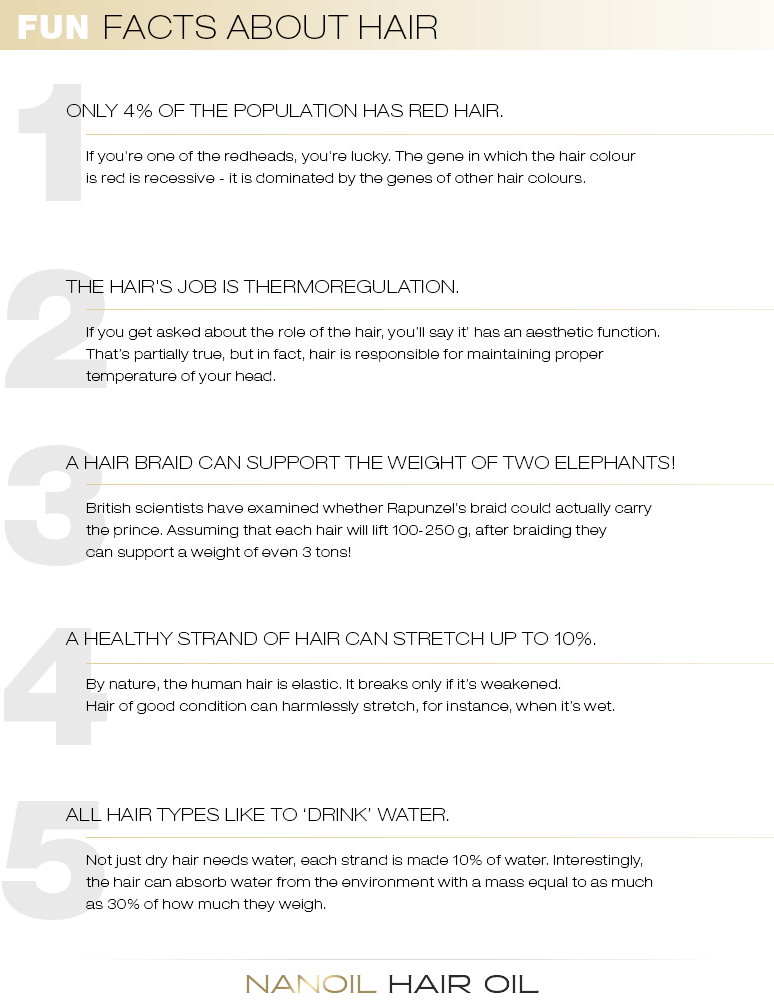- NANOIL Products
- Oils
- Face serums
- Hair masks
- Shampoos
- Hair conditioners
- Hair styling
- Hair Porosity Test
- Blog
- Contact

Although we have hundreds of thousands of hair on our head, we aren't aware of the load of information each of them carries. What's that you don't know about hair yet?
Indeed, there are hundreds of fun facts concerning hair. We don't know the half of them unless we work with hair regularly and professionally. Some of the information enumerated below won't rather influence the way you treat the hair daily, however, it can change the way you consider hair care to be. The truth is, we frequently expect impossible from the cosmetics we apply to the strands. In a moment you will learn why some products work whereas the other do nothing with our hair. Therefore, in order to understand your hair better, learn the fun facts that might surprise you. Here are the secrets concerning hair's anatomy and its care.

Is each hair built the same way?
To make a long story short, it's stated that each hair consists of two parts, which are a steam that is located above the scalp, and a root that is located in a follicle situated in the dermis. The steam, in turn, is made from three layers: cuticle (external), cortex (middle), and medulla (inner). Interestingly, thin hair doesn't have the inner layer at all, therefore, there is an empty space where thick hair has medulla. It's important to realize that different hair types have different shape in the cross-section. To demonstrate, straight hair is round, wavy hair is ellipse-shaped, curly looks like a flattered oval, frizzy hair is liver-shaped, and fil-fil hair (the strongest curl) resembles a croissant.
Is hair a living part of an organism?
The only hair part that lives is the hair bulb. This is the very place where all the processes, for example responsible for hair growth, take place. The remaining part of hair is dead and is composed of a tough, horny, keratin cells.
Is hair built from keratin only?
It can’t be denied, keratin is a protein which is a main building block of hair. After all 85% of a hair is made of this very protein. However, a healthy hair should also consist of more or less 10% of water, which makes hair moisturisation so crucial. The remaining building blocks are minerals, lipids (joining keratin cells) as well as the pigment - melanin that is responsible for gifting hair with its colour.
Does all hair grow at the same pace?
Hair that grows the fastest is the facial hair. The average pace of head hair growth is 1 cm per month. Of course, the maximum hair growth rate depends on many factors, both external and inner, therefore this indicator can differ in various people. Another interesting fact, it takes 7-8 years to obtain hair reaching waist from the moment one gets shaved bold. What’s more, according to researches, the fastest growing hair belongs to Asian people, hair growing in moderate pace belongs to European people, and African people's hair is believed to grow as the slowest. In general, male hair grows faster than female's, and this information isn't probably the one woman wanted to hear. What's interesting, the fastest hair growth rate is noticed during the summer.
Does trimming accelerate hair growth?
It's one of the myths that many people believe in. Unfortunately, there are no grounds to make this belief reasonable. Let it be stated once and for all, trimming doesn't have any influence over hair growth. What does have influence instead is the hair bulb activity.
Does hair grow after death?
Hair doesn't grow after death and the explanation of this is simple. When the organism is no longer alive all the cell division processes are stopped. Frequently, you can have the impression that hair of a deceased is longer, however, this is just an illusion created by contraction of the tissues that are close to hair.
Why are some babies born with their head covered with hair?
Hair follicles are formed in the third month of prenatal development. It's also worth mentioning that throughout the entire pregnancy, a baby is in constant contact with the mother's hormones the concentration of which is high. Naturally, this affects the born-to-be hair growth significantly. Moreover, the fact whether a baby has hair after birth also depends on, among others, genetics as well as ethnic origins. In most cases, the first hair falls out soon after the birth.
What's the maximum number of hair that can grow on head at the same time?
Every human is born with a defined number of follicles. Of course, this number can be boosted thanks to surgical procedures such as hair graft, for example. While discussing the issue of hair thickness, blonde people have the greatest number of hair, ginger-haired people the least, and the average number of hair have brown-haired people. Naturally, some of the hair follicles can be inactive. This means that thanks to proper care, we can awake the sleeping follicles and encourage baby hair growth. The average number of human hair equals 100-150 thousands. It’s also estimated that 1 cm2 of skin houses from 150 up to 170 hairs.
Does hair grow all life?
No, it doesn't. Each hair has its own cycle of life and it's different for eyelashes, facial hair and the hair growing on head. When it comes to the hair enumerated as the last ones, it remains in the growth phase from 2 up to 7 years. Naturally, the lifespan of a hair depends on many factors such as the state of a follicle, sex, etc. In average, 9 out of 10 hair are in the growth phase. At the same time, 10% of hair is dead and soon will be pushed out from the follicles by new hair. Throughout the entire life, a follicle grows from 20 to 30 hairs.
Is it possible to stop hair from falling out?
Hair loss is a completely natural process that is connected with hair’s life cycle. On average, we lose 80-100 hairs a day, however, there are various sources where the numbers vary. Anyway, we can talk about the problem of excessive hair loss or baldness when we lose more hair than 100 thorough a day.
Are diseases the only reason why hair falls out?
There are many reasons that have impact on growing hair loss problem. Frequently, it's connected with a disease entity like, for example, problems with a thyroid gland, cancer, anaemia as well as various kinds of infections. We can also lose hair in galore as the consequence of an antibiotic treatment, shortage of minerals (iron, zinc), menopause or andropause as well as stress, a contraception treatment, pregnancy and stimulants intake. Often, we aren't even aware of the fact that the first stages of baldness can be caused by slimming, inappropriate diet (too poor or by introducing drastic changes into it), or by improper care and styling which stands for using too heavy and overburdening cosmetics that mismatch hair's needs.
Why does hair tend to fall out excessively after pregnancy?
Indeed, pregnancy, or to be more precise, the hormones that are connected with pregnancy is one the reasons why hair falls out. When a woman is pregnant, the level of estrogen is really high and drops down rapidly after giving birth to her child. This sudden hormone drop results in excessive hair loss.
Can a hair hold weight a few times bigger than its own?
One of the most frequently repeated fun facts concerning hair is its endurance. A healthy and thick hair is stronger than a copper wire of the same diameter and can handle 250 gram load. It's worth pointing out that a hair of average length weights 1/1000 of gram. The strength of a hair is connected with its resistance to mechanical, biological and chemical factors.
Is hair really elastic?
One of the physical features of hair is its flexibility and elasticity. A healthy hair is able to stretch 10% of its normal length and this has no negative impact on its structure. It's worth realizing that wet hair stretch itself, and it loses the elasticity when exposed to warmth. Moreover, this stretching and elasticity of hair depends on the amount of water it is able to absorb from the surrounding.
Why is naturally ginger hair so rare to encounter?
It's important to realize that natural ginger hair belongs only to 4% of the entire human population. This information concerning the hair is inscribed in the genes and has to be transmitted by both parents, although, they don't have to be ginger. Also, this ginger-gene is often asleep because it always loses with other hair colours. Despite ginger-haired people being hard to find, this kind of humans enjoy natural colour of their hair longer than the others because red hair turns grey slower.
What's hair function?
Hairiness fulfils two very important missions which are a thermoregulatory and protective one, however, when it comes to humans these functions have become significantly limited. Indeed, head hair still provide protection and keep the temperature at the right level, however, in most cases, this kind of hair is treated as a beautifying factor only.
Does hair drink water?
Healthy hair has fairly well-developed ability to absorb water. The reports state that a hair is able to 'consume' water that weights 30% of the entire hair mass. This is the very reason why wet hair is way heavier than when dry. Of course, the more damaged the hair is, the greater amount of water it can absorb. Unfortunately, to its disadvantage.
Why is the study of hair called trichology, not hairology?
Although it may seem that hairology would be more appropriate name for the study of hair, the field of medicine that deals with diagnosing and treating hair and the scalp problems has its origins in a Greek word trikhos, which stands for hair.
Leave your email address and we ll notify you when it s back in stock.
Comments: #0